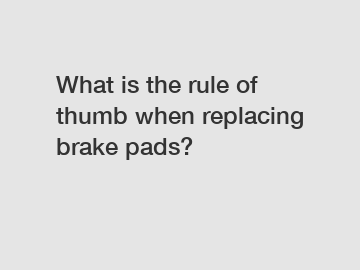What is the rule of thumb when replacing brake pads?
What is the rule of thumb when replacing brake pads?
Brake pads are an integral component of any vehicle's braking system. They are designed to provide the necessary friction to slow down or stop the vehicle when the brakes are applied. Over time, brake pads wear down and need to be replaced to ensure optimal performance and safety. But what is the rule of thumb when it comes to replacing brake pads? Let's explore this topic further.
Signs that it's time to replace brake pads.

Brake pads deteriorate over time due to the constant friction they experience during braking. It's important to keep an eye out for some common signs that indicate it's time to replace your brake pads. One of the most obvious signs is a squeaking or squealing noise coming from your brakes. This noise is caused by a small metal shim, called an indicator, which is embedded in the pads. When the pads wear down and the indicator comes into contact with the rotor, it produces a high-pitched noise.
Another sign to look out for is reduced braking efficiency. If you notice that your vehicle takes longer to stop or the brakes feel less responsive, it's likely that your brake pads are worn down. Additionally, vibrations or pulsations felt through the brake pedal could be an indication of unevenly worn brake pads or warped rotors. If you experience any of these signs, it's time to get your brake pads inspected and possibly replaced.
Determining when to replace brake pads.
Additional resources:The Power of LNG Semi-Trailers: Unlocking a Cleaner Future for Transportation
Side Wall Trailer: Enhancing Cargo Transport Efficiency and Safety
What you need to know about heavy industry?
Safety Procedures for LPG Forklifts
10 Comprehensive Buyer's Guide for HOWO Tractor Trucks
What brand brake pads does Ford use?
Which is the best LPG semi-trailer for a cost-effective purchase?
The general rule of thumb when it comes to replacing brake pads is to do so once they have worn down to a thickness of 3 millimeters. However, this rule can vary depending on various factors such as driving habits, vehicle type, and the type of brake pad material used. Some brake pads are designed to be more durable and may have a different wear limit. It's always best to consult your vehicle's manual or contact a professional mechanic to determine the specific wear limit for your brake pads.
It's important to note that neglecting to replace worn brake pads can have serious consequences. As the brake pads wear down, the friction material becomes thinner, reducing its ability to effectively stop the vehicle. This can lead to longer stopping distances, decreased control, and even brake failure in extreme cases. Regular inspection and maintenance of brake pads is crucial to ensure optimal safety on the road.
Choosing the right brake pads.
When replacing brake pads, it's essential to choose the right type for your vehicle. There are three main types of brake pad materials: organic, semi-metallic, and ceramic. Organic brake pads are made from natural materials and are generally quieter, but they tend to wear out more quickly. Semi-metallic brake pads have a higher metal content, providing better heat dissipation but may produce more noise. Ceramic brake pads are known for their durability, low noise, and consistent performance, but they can be more expensive.
In conclusion, the rule of thumb when replacing brake pads is to do so once they have worn down to a thickness of 3 millimeters. However, it's essential to pay attention to common signs of worn brake pads, such as squeaking noises, reduced braking efficiency, and vibrations. Neglecting to replace worn brake pads can jeopardize your safety on the road. Choosing the right brake pads for your vehicle is also important to ensure optimal performance. If you have any concerns or need assistance with your brake pads, don't hesitate to contact us. Our team of professionals is here to help ensure your vehicle's braking system is in top condition.
Want more information on European Car Brake Pads Manufacturer, Asian Vehicles Brake Pad Exporter, Asian Vehicles Brake Pad OEM Manufacturer? Feel free to contact us.
Additional resources:What are curtain side trailers used for?
What is the ISO regulation for containers?
Unlocking the Future of LNG Shipping: ISO Tank Containers Demystified!
What is the introduction of vehicle brake system?
Unveiling the Future of Safe & Efficient LPG Transportation: Discover the Advantages of LPG Semi-Trailers
What is the best pressure for CNG filling?
What are better brake pads ceramic or semi-metallic?

Comments
0